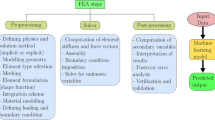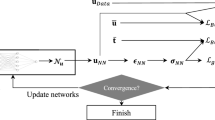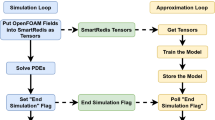Abstract
In this contribution, we develop an efficient surrogate modeling framework for simulation-based optimization of enhanced oil recovery, where we particularly focus on polymer flooding. The computational approach is based on an adaptive training procedure of a neural network that directly approximates an input-output map of the underlying PDE-constrained optimization problem. The training process thereby focuses on the construction of an accurate surrogate model solely related to the optimization path of an outer iterative optimization loop. True evaluations of the objective function are used to finally obtain certified results. Numerical experiments are given to evaluate the accuracy and efficiency of the approach for a heterogeneous five-spot benchmark problem.
Article PDF
Similar content being viewed by others
Avoid common mistakes on your manuscript.
References
Pancholi, S., Negi, G.S., Agarwal, J.R., Bera, A., Shah, M.: Experimental and simulation studies for optimization of water–alternating-gas (CO2) flooding for enhanced oil recovery. Petroleum Res. 5(3), 227–234 (2020). https://doi.org/10.1016/j.ptlrs.2020.04.004
Van, S.L., Chon, B.H.: Well-pattern investigation and selection by surfactant-polymer flooding performance in heterogeneous reservoir consisting of interbedded low-permeability layer. Kor. J. Chem. Eng. 33 (12), 3456–3464 (2016). https://doi.org/10.1007/s11814-016-0190-7
Zhang, Y., Lu, R., Forouzanfar, F., Reynolds, A.C.: Well placement and control optimization for WAG/SAG processes using ensemble-based method. Comput. Chem. Eng. 101, 193–209 (2017). https://doi.org/10.1016/j.compchemeng.2017.02.020
Gudiña, E.J., Fernandes, E.C., Rodrigues, A.I., Teixeira, J.A., Rodrigues, L.R.: Biosurfactant production by bacillus subtilis using corn steep liquor as culture medium. Front. Microbiol. 6, 59 (2015). https://doi.org/10.3389/fmicb.2015.00059
Abidin, A., Puspasari, T., Nugroho, W.: Polymers for enhanced oil recovery technology. Procedia Chemistry 4, 11–16 (2012). https://doi.org/10.1016/j.proche.2012.06.002
Wang, D., Seright, R.S., Shao, Z., Wang, J., et al.: Key aspects of project design for polymer flooding at the daqing oilfield. SPE Reserv Eval Eng 11(06), 1–117 (2008). https://doi.org/10.2118/109682-PA
Oguntola, M.B., Lorentzen, R.J.: On the robust value quantification of polymer eor injection strategies for better decision making. In: ECMOR XVII. https://doi.org/10.3997/2214-4609.202035057. European Association of Geoscientists & Engineers, vol. 2020, pp 1–25 (2020)
Xu, L., Zhao, H., Li, Y., Cao, L., Xie, X., Zhang, X., Li, Y.: Production optimization of polymer flooding using improved monte carlo gradient approximation algorithm with constraints. J. Circ. Syst. Comput. 27 (11), 1850167 (2018). https://doi.org/10.1142/S0218126618501670
Zhou, K., Hou, J., Zhang, X., Du, Q., Kang, X., Jiang, S.: Optimal control of polymer flooding based on simultaneous perturbation stochastic approximation method guided by finite difference gradient. Comput. Chem. Eng. 55, 40–49 (2013). https://doi.org/10.1016/j.compchemeng.2013.04.009
Dedè, L.: Reduced basis method and error estimation for parametrized optimal control problems with control constraints. J. Sci. Comput. 50(2), 287–305 (2012)
Grepl, M.A., Kärcher, M.: Reduced basis a posteriori error bounds for parametrized linear-quadratic elliptic optimal control problems. C.R. Math. 349(15-16), 873–877 (2011)
Kammann, E., Tröltzsch, F., Volkwein, S.: A posteriori error estimation for semilinear parabolic optimal control problems with application to model reduction by POD. ESAIM: M2AN 47(2), 555–581 (2013). https://doi.org/10.1051/m2an/2012037
Kärcher, M., Tokoutsi, Z., Grepl, M.A., Veroy, K.: Certified reduced basis methods for parametrized elliptic optimal control problems with distributed controls. J. Sci. Comput. 75(1), 276–307 (2018)
Negri, F., Rozza, G., Manzoni, A., Quateroni, A.: Reduced basis method for parametrized elliptic optimal control problems. SIAM J. Sci. Comput. 35(5), 2316–2340 (2013). https://doi.org/10.1137/120894737
Benner, P., Ohlberger, M., Patera, A., Rozza, G., Urban, K. (eds.): Model reduction of parametrized systems. MS&A. modeling, simulation and applications, vol. 17. Springer, Berlin (2017). https://doi.org/10.1007/978-3-319-58786-8. Selected papers from the 3rd MoRePaS Conference held at the International School for Advanced Studies (SISSA), Trieste, October 13–16, 2015
Garmatter, D., Haasdonk, B., Harrach, B.: A reduced basis Landweber method for nonlinear inverse problems. Inverse Prob. 32(3), 035001–21 (2016). https://doi.org/10.1088/0266-5611/32/3/035001
Zahr, M.J., Farhat, C.: Progressive construction of a parametric reduced-order model for PDE-constrained optimization. Int. J. Numer. Meth. Engng 102, 1111–1135 (2015). https://doi.org/10.1002/nme.4770
Keil, T., Mechelli, L., Ohlberger, M., Schindler, F., Volkwein, S.: A non-conforming dual approach for adaptive trust-region reduced basis approximation of PDE-constrained parameter optimization. ESAIM Math. Model. Numer. Anal. 55(3), 1239–1269 (2021). https://doi.org/10.1051/m2an/2021019
Qian, E., Grepl, M., Veroy, K., Willcox, K.: A certified trust region reduced basis approach to PDE-constrained optimization. SIAM J. Sci. Comput. 39(5), 434–460 (2017). https://doi.org/10.1137/16M1081981
Yue, Y., Meerbergen, K.: Accelerating optimization of parametric linear systems by model order reduction. SIAM J. Optim. 23(2), 1344–1370 (2013). https://doi.org/10.1137/120869171
Gavrilenko, P., Haasdonk, B., Iliev, O., Ohlberger, M., Schindler, F., Toktaliev, P., Wenzel, T., Youssef, M.: A full order, reduced order and machine learning model pipeline for efficient prediction of reactive flows. arXiv:2104.02800v2 (2021)
Haasdonk, B., Kleikamp, H., Ohlberger, M., Schindler, F., Wenzel, T.: A new certified hierarchical and adaptive RB-ML-ROM surrogate model for parametrized PDEs. arXiv:2204.13454 (2022)
Haasdonk, B., Ohlberger, M., Schindler, F.: An adaptive model hierarchy for data-augmented training of kernel models for reactive flow. arXiv:2110.12388v1 (2021)
Hesthaven, J.S., Ubbiali, S.: Non-intrusive reduced order modeling of nonlinear problems using neural networks. J. Comput. Phys. 363, 55–78 (2018). https://doi.org/10.1016/j.jcp.2018.02.037
Wang, Q., Hesthaven, J.S., Ray, D.: Non-intrusive reduced order modeling of unsteady flows using artificial neural networks with application to a combustion problem. J. Comput. Phys. 384, 289–307 (2019). https://doi.org/10.1016/j.jcp.2019.01.031
Lee, K., Carlberg, K.T.: Model reduction of dynamical systems on nonlinear manifolds using deep convolutional autoencoders. J. Comput. Phys. 404, 108973–32 (2020). https://doi.org/10.1016/j.jcp.2019.108973
Ahmadi, M.A.: Developing a robust surrogate model of chemical flooding based on the artificial neural network for enhanced oil recovery implications. Math. Probl. Eng. 2015, 9 (2015). https://doi.org/10.1155/2015/706897
Saberi, H., Esmaeilnezhad, E., Choi, H.J.: Artificial neural network to forecast enhanced oil recovery using hydrolyzed polyacrylamide in sandstone and carbonate reservoirs. Polymers 13(16). https://doi.org/10.3390/polym13162606 (2021)
Cheraghi, Y., Kord, S., Mashayekhizadeh, V.: Application of machine learning techniques for selecting the most suitable enhanced oil recovery method; challenges and opportunities. J. Pet. Sci. Eng. 205, 108761 (2021). https://doi.org/10.1016/j.petrol.2021.108761
Golzari, A., Haghighat Sefat, M., Jamshidi, S.: Development of an adaptive surrogate model for production optimization. J. Pet. Sci. Eng. 133, 677–688 (2015). https://doi.org/10.1016/j.petrol.2015.07.012
Lee, J.-Y., Shin, H.-J., Lim, J.-S.: Selection and evaluation of enhanced oil recovery method using artificial neural network. Geosystem Engineering 14, 157–164 (2011). https://doi.org/10.1080/12269328.2011.10541345
Lye, K.O., Mishra, S., Ray, D., Chandrashekar, P.: Iterative surrogate model optimization (ISMO): An active learning algorithm for PDE constrained optimization with deep neural networks. Comput. Methods Appl. Mech. Eng. 374, 113575 (2021). https://doi.org/10.1016/j.cma.2020.113575
Wang, S., Bhouri, M.A., Perdikaris, P.: Fast PDE-constrained optimization via self-supervised operator learning. arXiv:2110.13297 (2021)
Sarma, P., Durlofsky, L.J., Aziz, K., Chen, W.H.: Efficient real-time reservoir management using adjoint-based optimal control and model updating. Comput. Geosci. 10 (1), 3–36 (2006). https://doi.org/10.1007/s10596-005-9009-z
Rasmussen, A.F., Sandve, T.H., Bao, K., Lauser, A., Hove, J., Skaflestad, B., Klöfkorn, R., Blatt, M., Rustad, A.B., Sævareid, O., et al: The open porous media flow reservoir simulator. Computers & Mathematics with Applications 81, 159–185 (2021). https://doi.org/10.1016/j.camwa.2020.05.014
Bao, K., Lie, K. -A., Møyner, O., Liu, M.: Fully implicit simulation of polymer flooding with MRST. Comput. Geosci. 21(5), 1219–1244 (2017). https://doi.org/10.1007/s10596-017-9624-5
Holmes, J.: Enhancements to the strongly coupled, fully implicit well model: wellbore crossflow modeling and collective well control. In: SPE Reservoir Simulation Symposium. https://doi.org/10.2118/12259-MS.OnePetro (1983)
Holmes, J., Barkve, T., Lund, O.: Application of a multisegment well model to simulate flow in advanced wells. In: European Petroleum Conference. https://doi.org/10.2118/50646-MS.OnePetro (1998)
Chen, Z.: Reservoir simulation: Mathematical techniques in oil recovery. SIAM (2007)
Lu, R., Reynolds, A.: Joint optimization of well locations, types, drilling order, and controls given a set of potential drilling paths. SPE J. 25 (03), 1285–1306 (2020). https://doi.org/10.2118/193885-MS
Chen, Y., Oliver, D.S., Zhang, D.: Efficient ensemble-based closed-loop production optimization. SPE J. 14(04), 634–645 (2009). https://doi.org/10.2118/112873-PA
Stordal, A.S., Szklarz, S.P., Leeuwenburgh, O.: A theoretical look at ensemble-based optimization in reservoir management. Math. Geosci. 48(4), 399–417 (2016). https://doi.org/10.1007/s11004-015-9598-6
Nocedal, J., Wright, S.: Numerical optimization springer. https://doi.org/10.1007/978-0-387-40065-5 (2006)
Montgomery, D.C., Jennings, C.L., Kulahci, M.: Introduction to time series analysis and forecasting. Wiley, Hoboken (2015)
Fonseca, R.R.-M., Chen, B., Jansen, J.D., Reynolds, A.: A stochastic simplex approximate gradient (stosag) for optimization under uncertainty. Int. J. Numer. Methods Eng. 109(13), 1756–1776 (2017). https://doi.org/10.1002/nme.5342
Oguntola, M.B., Lorentzen, R.J.: Ensemble-based constrained optimization using an exterior penalty method. J. Pet. Sci. Eng. 207, 109165 (2021). https://doi.org/10.1016/j.petrol.2021.109165
Petersen, P., Voigtlaender, F.: Optimal approximation of piecewise smooth functions using deep reLU neural networks. Neural Netw. 108, 296–330 (2018). https://doi.org/10.1016/j.neunet.2018.08.019
Elbrächter, D., Grohs, P., Jentzen, A., Schwab, C.: DNN Expression rate analysis of high-dimensional PDEs: Application to option pricing. Constructive Approximation. https://doi.org/10.1007/s00365-021-09541-6 (2021)
Bottou, L., Curtis, F.E., Nocedal, J.: Optimization methods for large-scale machine learning. SIAM Rev. 60(2), 223–311 (2018). https://doi.org/10.1137/16M1080173
Liu, D.C., Nocedal, J.: On the limited memory BFGS method for large scale optimization. Math. Program. 45, 503–528 (1989). https://doi.org/10.1007/BF01589116
Prechelt, L.: Early stopping - but when?. In: Neural Networks: Tricks of the Trade, Volume 1524 of LNCS, Chapter 2. https://doi.org/10.1007/978-3-642-35289-8∖_5, pp 55–69. Springer (1997)
He, K., Zhang, X., Ren, S., Sun, J.: Delving deep into rectifiers: Surpassing human-level performance on imagenet classification. In: 2015 IEEE International Conference on Computer Vision (ICCV), pp. 1026–1034. https://doi.org/10.1109/ICCV.2015.123 (2015)
LeCun, Y., Bengio, Y., Hinton, G.: Deep learning. Nature 521, 436–44 (2015). https://doi.org/10.1038/nature14539
Fonseca, R., Kahrobaei, S., Van Gastel, L., Leeuwenburgh, O., Jansen, J.: Quantification of the impact of ensemble size on the quality of an ensemble gradient using principles of hypothesis testing. In: SPE Reservoir Simulation Symposium. https://doi.org/SPE-173236-MS. OnePetro (2015)
Baxendale, D., Rasmussen, A.F., Rustad, A.B., Skille, T., Sandve, T.H.: OPM Flow documentation manual. Open Porous Media Initiative (2021)
Milk, R., Rave, S., Schindler, F.: PyMOR – generic algorithms and interfaces for model order reduction. SIAM J. Sci. Comput. 38(5), 194–216 (2016). https://doi.org/10.1137/15m1026614
Paszke, A., Gross, S., Massa, F., Lerer, A., Bradbury, J., Chanan, G., Killeen, T., Lin, Z., Gimelshein, N., Antiga, L., Desmaison, A., Kopf, A., Yang, E., DeVito, Z., Raison, M., Tejani, A., Chilamkurthy, S., Steiner, B., Fang, L., Bai, J., Chintala, S.: Pytorch: An imperative style, high-performance deep learning library. In: Wallach, H., Larochelle, H., Beygelzimer, A., d’ Alché-Buc, F., Fox, E., Garnett, R (eds.) Advances in Neural Information Processing Systems, vol. 32, pp 8024–8035. Curran Associates Inc (2019)
Wolfe, P.: Convergence conditions for ascent methods. SIAM Rev. 13(2), 185–188 (1971). https://doi.org/10.1137/1013035
Hofmann, T., Schölkopf, B., Smola, A.J.: Kernel methods in machine learning. Ann. Stat. 36(3), 1171–1220 (2008). https://doi.org/10.1214/009053607000000677
Funding
Open access funding provided by University Of Stavanger • Tim Keil, Hendrik Kleikamp, Micheal Oguntola and Mario Ohlberger received funding from the Deutsche Forschungsgemeinschaft (DFG, German Research Foundation) under Germany’s Excellence Strategy EXC 2044 –390685587, Mathematics Münster: Dynamics–Geometry–Structure.
• Tim Keil and Mario Ohlberger received funding from the Deutsche Forschungsgemeinschaft under contract OH 98/11-1.
• Micheal Oguntola and Rolf Lorentzen received funding from the Research Council of Norway and the industry partners, ConocoPhillips Skandinavia AS, Aker BP ASA, Vår Energi AS, Equinor Energy AS, Neptune Energy Norge AS, Lundin Energy Norway AS, Halliburton AS, Schlumberger Norge AS, and Wintershall Dea Norge AS, of The National IOR Centre of Norway.
Author information
Authors and Affiliations
Corresponding author
Ethics declarations
Conflict of interest
The authors declare no competing interests.
Additional information
Communicated by: Gianluigi Rozza
Publisher’s note
Springer Nature remains neutral with regard to jurisdictional claims in published maps and institutional affiliations.
Rights and permissions
Open Access This article is licensed under a Creative Commons Attribution 4.0 International License, which permits use, sharing, adaptation, distribution and reproduction in any medium or format, as long as you give appropriate credit to the original author(s) and the source, provide a link to the Creative Commons licence, and indicate if changes were made. The images or other third party material in this article are included in the article's Creative Commons licence, unless indicated otherwise in a credit line to the material. If material is not included in the article's Creative Commons licence and your intended use is not permitted by statutory regulation or exceeds the permitted use, you will need to obtain permission directly from the copyright holder. To view a copy of this licence, visit http://creativecommons.org/licenses/by/4.0/.
About this article
Cite this article
Keil, T., Kleikamp, H., Lorentzen, R.J. et al. Adaptive machine learning-based surrogate modeling to accelerate PDE-constrained optimization in enhanced oil recovery. Adv Comput Math 48, 73 (2022). https://doi.org/10.1007/s10444-022-09981-z
Received:
Accepted:
Published:
DOI: https://doi.org/10.1007/s10444-022-09981-z
Keywords
- PDE-constrained optimization
- Enhanced oil recovery
- Machine learning
- Neural networks
- Surrogate modeling
- Ensemble-based optimization




